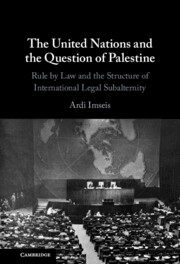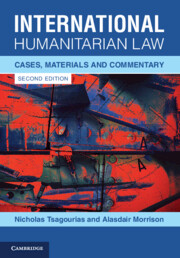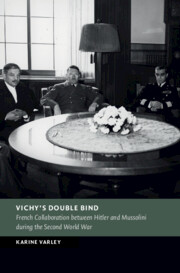122 results
16 - The Application of Human Rights in Armed Conflict
-
- Book:
- International Human Rights Law and Practice
- Published online:
- 08 February 2024
- Print publication:
- 15 February 2024, pp 744-775
-
- Chapter
- Export citation
Musical convergence and divergence in occupied İstanbul, 1918–1923
-
- Journal:
- New Perspectives on Turkey , First View
- Published online by Cambridge University Press:
- 29 January 2024, pp. 1-19
-
- Article
- Export citation
8 - The Legacy of Max Sering and Inner Colonization
-
- Book:
- Frontiers of Empire
- Published online:
- 04 January 2024
- Print publication:
- 25 January 2024, pp 254-274
-
- Chapter
- Export citation
Overcoming a stigmatic past: National Central University students in Nanjing, China, and the politics of wartime history
-
- Journal:
- Modern Asian Studies / Volume 58 / Issue 1 / January 2024
- Published online by Cambridge University Press:
- 18 March 2024, pp. 78-100
- Print publication:
- January 2024
-
- Article
- Export citation
17 - The Tokugawa Status Order
- from Part III - Social Practices and Cultures of Early Modern Japan
-
-
- Book:
- The New Cambridge History of Japan
- Published online:
- 15 January 2024
- Print publication:
- 23 November 2023, pp 567-602
-
- Chapter
- Export citation

The United Nations and the Question of Palestine
- Rule by Law and the Structure of International Legal Subalternity
-
- Published online:
- 16 November 2023
- Print publication:
- 30 November 2023
18 - Patriotism in the Second World War: Comparative Perspectives on Countries under Axis Occupation
- from Part ii - Paradigm Shifts and Turning Points in the Era of Globalization, 1500 to the Present
-
-
- Book:
- The Cambridge History of Nationhood and Nationalism
- Published online:
- 27 October 2023
- Print publication:
- 09 November 2023, pp 399-420
-
- Chapter
- Export citation
11 - The Law of Armed Conflict
- from Part II - The Substance of International Law
-
- Book:
- International Law
- Published online:
- 19 October 2023
- Print publication:
- 02 November 2023, pp 218-234
-
- Chapter
- Export citation
The Constitutional Overhaul and the West Bank: Is Israel's Constitutional Moment Occupied?
-
- Journal:
- Israel Law Review / Volume 56 / Issue 3 / November 2023
- Published online by Cambridge University Press:
- 15 November 2023, pp. 415-425
- Print publication:
- November 2023
-
- Article
- Export citation
After the Gang: Desistance, Violence and Occupational Options in Nicaragua
-
- Journal:
- Journal of Latin American Studies / Volume 55 / Issue 4 / November 2023
- Published online by Cambridge University Press:
- 05 October 2023, pp. 679-704
- Print publication:
- November 2023
-
- Article
-
- You have access
- Open access
- HTML
- Export citation
1 - Definition and Classification of Armed Conflicts
-
- Book:
- International Humanitarian Law
- Published online:
- 24 August 2023
- Print publication:
- 07 September 2023, pp 1-41
-
- Chapter
- Export citation

International Humanitarian Law
- Cases, Materials and Commentary
-
- Published online:
- 24 August 2023
- Print publication:
- 07 September 2023
-
- Textbook
- Export citation
11 - From Demonizing to Dehumanizing
-
- Book:
- Right and Wronged in International Relations
- Published online:
- 29 July 2023
- Print publication:
- 10 August 2023, pp 336-367
-
- Chapter
- Export citation
A possible legal framework for the exploitation of natural resources by non-State armed groups
-
- Journal:
- International Review of the Red Cross / Volume 105 / Issue 924 / December 2023
- Published online by Cambridge University Press:
- 03 July 2023, pp. 1522-1542
-
- Article
- Export citation
Chapter 4 - Compliance and Defiance
- from Part I - Diplomacy and Politics
-
- Book:
- Vichy's Double Bind
- Published online:
- 18 May 2023
- Print publication:
- 01 June 2023, pp 77-97
-
- Chapter
- Export citation
Conclusion
- from Part II - Local Encounters
-
- Book:
- Vichy's Double Bind
- Published online:
- 18 May 2023
- Print publication:
- 01 June 2023, pp 186-194
-
- Chapter
- Export citation

Vichy's Double Bind
- French Collaboration between Hitler and Mussolini during the Second World War
-
- Published online:
- 18 May 2023
- Print publication:
- 01 June 2023
New Wild Fields: How the Russian War Leads to the Demodernization of Ukraine’s Occupied Territories
-
- Journal:
- Nationalities Papers / Volume 52 / Issue 3 / May 2024
- Published online by Cambridge University Press:
- 11 May 2023, pp. 497-515
- Print publication:
- May 2024
-
- Article
-
- You have access
- Open access
- HTML
- Export citation
5 - “The Power of Christian Truth and Christian Faith”
-
- Book:
- Between God and Hitler
- Published online:
- 14 April 2023
- Print publication:
- 11 May 2023, pp 147-171
-
- Chapter
- Export citation
Work and Identity in Early Modern England
-
- Journal:
- Transactions of the Royal Historical Society / Volume 1 / December 2023
- Published online by Cambridge University Press:
- 10 May 2023, pp. 145-158
- Print publication:
- December 2023
-
- Article
-
- You have access
- Open access
- HTML
- Export citation



